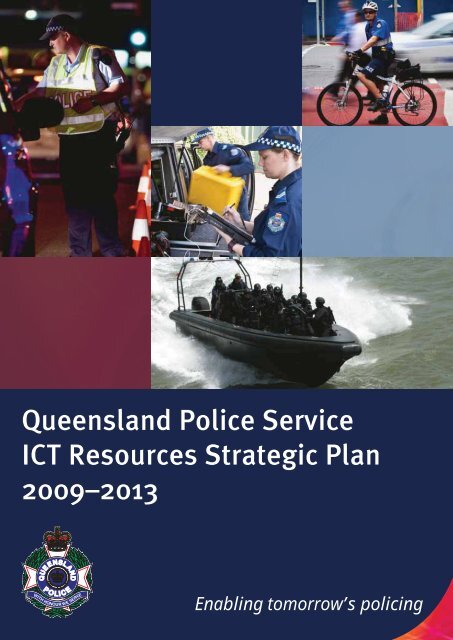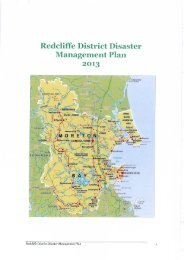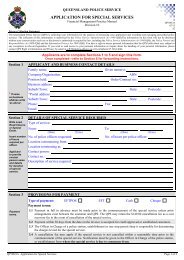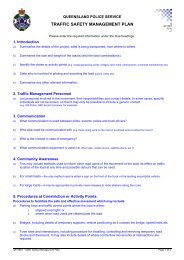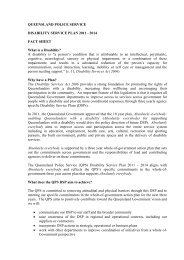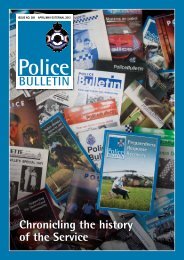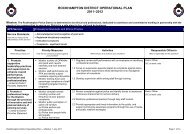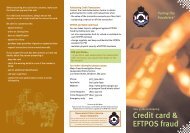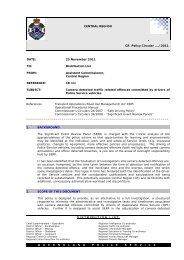QPS ICT Resources Strategic Plan - Queensland Police Service ...
QPS ICT Resources Strategic Plan - Queensland Police Service ...
QPS ICT Resources Strategic Plan - Queensland Police Service ...
Create successful ePaper yourself
Turn your PDF publications into a flip-book with our unique Google optimized e-Paper software.
<strong>Queensland</strong> <strong>Police</strong> <strong>Service</strong><br />
<strong>ICT</strong> <strong>Resources</strong> <strong>Strategic</strong> <strong>Plan</strong><br />
2009–2013<br />
Enabling tomorrow’s policing
<strong>QPS</strong> <strong>ICT</strong> <strong>Resources</strong> <strong>Strategic</strong> <strong>Plan</strong> 2009–2013
Commissioner’s foreword .................................................................... 4<br />
Introduction ...................................................................................... 5-6<br />
Aims of the plan .................................................................................. 7<br />
About policing and <strong>ICT</strong> services .......................................................... 8<br />
<strong>Strategic</strong> drivers of change.................................................................. 9<br />
<strong>ICT</strong> trends of other organisations.......................................................10<br />
Vision for <strong>QPS</strong> <strong>ICT</strong> resources ..............................................................12<br />
Guiding principles ...............................................................................13<br />
<strong>ICT</strong> strategies ......................................................................................15<br />
Implementing the plan .......................................................................18<br />
C<br />
O<br />
N<br />
T<br />
E<br />
N<br />
T<br />
S<br />
Roadmap ............................................................................................19<br />
Definition<br />
The following definition should be used when reading this document.<br />
Term<br />
<strong>QPS</strong> <strong>ICT</strong> <strong>Resources</strong><br />
Definition<br />
This term refers to <strong>ICT</strong> resources used by the <strong>Service</strong> to meet its business objectives. This<br />
includes resources such as software to process information. The <strong>QPS</strong> <strong>ICT</strong> organisational unit<br />
represents a subset of the <strong>Service</strong>’s <strong>ICT</strong> resources.<br />
Document control<br />
Status<br />
Date March 22, 2010<br />
Approved by Commissioner, <strong>Queensland</strong> <strong>Police</strong> <strong>Service</strong><br />
Contact <strong>Queensland</strong> <strong>Police</strong> <strong>Service</strong> GPO Box 1440 Brisbane QLD 4000<br />
© The State of <strong>Queensland</strong> (<strong>Queensland</strong> <strong>Police</strong> <strong>Service</strong>) 2009<br />
<strong>QPS</strong> <strong>ICT</strong> <strong>Resources</strong> <strong>Strategic</strong> <strong>Plan</strong> 2009–2013
Commissioner’s foreword<br />
The vision of the <strong>Queensland</strong> <strong>Police</strong> <strong>Service</strong> (<strong>QPS</strong>) is <strong>Queensland</strong> is a safe and secure place to live,<br />
visit and do business.<br />
Looking ahead, maintaining a high level of community engagement and confidence while fighting<br />
crime, improving road safety, and responding to community needs will be an ongoing challenge.<br />
That challenge will be enhanced by the effects of climate change, economic volatility, an aging<br />
population and delivering a high quality, 24/7 policing service to the fastest growing and most<br />
decentralised state in Australia.<br />
Information Communications Technology (<strong>ICT</strong>) resources have an important part to play in supporting<br />
this vision and in meeting the challenges that lie ahead. Indeed, as a modern policing organisation<br />
the <strong>Service</strong> depends heavily on <strong>ICT</strong> resources to carry out its daily activities.<br />
There are opportunities to make more productive and effective use of the <strong>Service</strong>’s resources to<br />
improve operational performance. To that end, this <strong>ICT</strong> <strong>Resources</strong> <strong>Strategic</strong> <strong>Plan</strong> 2009–2013 (this<br />
<strong>Plan</strong>) sets out strategies to assist frontline police, and therefore the community, in numerous ways,<br />
including:<br />
• making more informed decisions in tasking resources for improved response and officer and<br />
community safety<br />
• ensuring officers remain in the field and are as operationally effective as possible whilst working<br />
with the community<br />
• leveraging the wealth of information the <strong>Service</strong> collects by identifying trends and responding<br />
operationally, or with adjustments to policy, procedure or legislation<br />
• establishing better ways to work in partnership with the community<br />
• continuing to contribute towards state and national agendas.<br />
This <strong>Plan</strong> outlines the necessary advancements through which the <strong>Service</strong> can successfully continue<br />
its mission to deliver high quality, innovative, progressive and responsive policing services.<br />
This <strong>Plan</strong> represents an essential part of our future and has my full support.<br />
Bob Atkinson APM<br />
Commissioner<br />
<strong>Queensland</strong> <strong>Police</strong> <strong>Service</strong><br />
4 <strong>QPS</strong> <strong>ICT</strong> <strong>Resources</strong> <strong>Strategic</strong> <strong>Plan</strong> 2009–2013
Introduction<br />
This <strong>Plan</strong> is part of an on-going journey for the <strong>Service</strong>’s <strong>ICT</strong> resources and therefore it is appropriate<br />
and important to recognise achievements and progress made since the last major planning activity.<br />
These and other initiatives put in place a foundation that is essential to building future capabilities to<br />
better support policing.<br />
Incident<br />
response<br />
Operational<br />
policing<br />
The <strong>Service</strong> is well advanced in establishing a dedicated non-urgent multichannel<br />
contact centre to improve client service, police productivity, and contact<br />
management. Also, significant progress is being made in modernising the Computer<br />
Aided Dispatch (CAD) system.<br />
<strong>Queensland</strong> <strong>Police</strong> Records & Information Management Exchange (QPRIME) is an<br />
integrated, 24/7 policing solution that replaced over 200 information silos used for<br />
incident recording, management, and investigation.<br />
QPRIME provides a single view of people and objects of interest and includes<br />
information analysis capabilities, as well as providing a platform for information<br />
sharing, both internally and externally.<br />
Improvements for road safety will result from transitioning to digital based technology<br />
for speed and red light infringements, including back office processing efficiencies.<br />
Advances in<br />
technology<br />
Information<br />
sharing<br />
Core <strong>ICT</strong><br />
infrastructure<br />
Fingerprint scanning devices have been implemented in nominated watchhouses,<br />
significantly shortening timeframes for identification.<br />
An award winning forensics system allows forensics staff to operate in the field<br />
supporting the gathering and analysis of physical evidence in significantly reduced<br />
timeframes.<br />
Participation in multi-agency initiatives focused on information sharing (eg the<br />
electronic transfer of charges and court results, and the National <strong>Police</strong> Reference<br />
System) has increased efficiency and effectiveness for police.<br />
<strong>QPS</strong> is the lead agency for the Public Safety Network initiative, which is delivering<br />
major network security, reliability and capacity upgrades (especially to remote<br />
stations) while achieving whole-of-government economies-of-scale through the<br />
sharing of fixed data network infrastructure between agencies.<br />
<strong>QPS</strong> <strong>ICT</strong> <strong>Resources</strong> <strong>Strategic</strong> <strong>Plan</strong> 2009–2013<br />
5
In future years, the foundation will be enhanced through a range of strategic initiatives enabling police<br />
to access and record information in the field, while maximising contact with command and improving<br />
the response to community requests for service.<br />
The <strong>Service</strong> will continue to work with its business partners (primarily criminal justice and law<br />
enforcement agencies, emergency service organisations and transport authorities) to enhance<br />
efficiency and effectiveness through increased interoperability, and sharing of information and <strong>ICT</strong><br />
infrastructure.<br />
In parallel, existing capabilities will be maintained through an ongoing technology refresh program<br />
and continual improvements made to the delivery of <strong>ICT</strong> services within <strong>QPS</strong> (such as corporate<br />
governance, architecture, and sourcing models).<br />
The importance of information to operational police underlines the need for strategic management of<br />
the <strong>Service</strong>’s overall <strong>ICT</strong> capability, beyond the delivery of any particular initiative. This <strong>Plan</strong> plays a<br />
very important role in achieving this and the <strong>Queensland</strong> Government’s strategy of Toward Q2 through<br />
<strong>ICT</strong>.<br />
In light of the above it is clear that the role of <strong>ICT</strong> resources in policing continues to expand, adding<br />
value to both core policing and support functions of the <strong>Service</strong>.<br />
I look forward to working with people throughout the <strong>Service</strong>, the <strong>Queensland</strong> Government,<br />
Commonwealth agencies and the <strong>ICT</strong> industry to make this <strong>Plan</strong> a reality.<br />
Paul Stewart<br />
Assistant Commissioner, Information and Communications Technology<br />
<strong>Queensland</strong> <strong>Police</strong> <strong>Service</strong><br />
6 <strong>QPS</strong> <strong>ICT</strong> <strong>Resources</strong> <strong>Strategic</strong> <strong>Plan</strong> 2009–2013
Aims of the plan<br />
This <strong>Plan</strong> recognises the significant and varied demands for <strong>ICT</strong> resources by ensuring all needs are<br />
defined and are supportive of achieving the <strong>Service</strong>’s organisational goals and objectives into the<br />
future.<br />
This <strong>Plan</strong> aims to ensure investment decisions are optimised for the benefit of the <strong>Service</strong>, and for its<br />
stakeholders, by:<br />
• comprehensively representing the strategic <strong>ICT</strong>-related requirements of the organisation;<br />
• providing an ongoing management tool from which to consider any changes in priority and/or any<br />
new demands;<br />
• establishing a plan which is achievable and measurable, and promotes accountability for the<br />
potential significant investment it represents;<br />
• engaging all relevant stakeholders in a process which facilitates greater sharing and understanding<br />
between and amongst individual units; and<br />
• providing a mechanism by which whole-of-government directions can also be supported.<br />
Lastly, this <strong>Plan</strong> will form the basis from which individual organisational units’ <strong>ICT</strong>-related plans can<br />
be formulated, thereby ensuring all relevant activities within the <strong>Service</strong> are focused on the most<br />
important things that need to be done.<br />
The below diagram illustrates the relationship of this <strong>Plan</strong> to the <strong>QPS</strong> <strong>Strategic</strong> <strong>Plan</strong> and to the <strong>ICT</strong>related<br />
plans of the <strong>Service</strong>’s organisational units.<br />
<strong>QPS</strong> <strong>Strategic</strong> and Operational <strong>Plan</strong>s<br />
<strong>QPS</strong><br />
Objectives<br />
To reduce the incidence and<br />
impact of crime and road trauma in<br />
<strong>Queensland</strong><br />
To strengthen <strong>Queensland</strong>’s capacity<br />
to plan for, respond to, and recover<br />
from disasters and major events<br />
To enhance community confi dence<br />
in, and satisfaction, with policing in<br />
<strong>Queensland</strong><br />
<strong>QPS</strong> <strong>Strategic</strong><br />
<strong>Plan</strong>ning Elements<br />
(informed by Regions,<br />
Commands, and<br />
Divisions)<br />
Operational<br />
policing<br />
Specialist<br />
services<br />
<strong>ICT</strong><br />
<strong>Resources</strong><br />
Finance People Property and<br />
Facilities<br />
Other<br />
<strong>QPS</strong> <strong>ICT</strong> <strong>Resources</strong> <strong>Strategic</strong> <strong>Plan</strong><br />
<strong>QPS</strong> <strong>ICT</strong> <strong>Resources</strong> <strong>Strategic</strong> <strong>Plan</strong>—Program of Work<br />
<strong>QPS</strong> Business <strong>Plan</strong>s and Activities<br />
(supported by <strong>QPS</strong> <strong>ICT</strong> <strong>Resources</strong> <strong>Strategic</strong> <strong>Plan</strong>)<br />
Regions Commands Divisions<br />
<strong>QPS</strong> <strong>ICT</strong> <strong>Resources</strong> <strong>Strategic</strong> <strong>Plan</strong> 2009–2013<br />
7
About policing and <strong>ICT</strong> services<br />
The <strong>Queensland</strong> <strong>Police</strong> <strong>Service</strong> provides quality policing services 24 hours a day to <strong>Queensland</strong><br />
residents and visitors, with the following core services that collectively support the community:<br />
<strong>Police</strong> <strong>Service</strong> Delivery<br />
Personal Safety<br />
Property Security<br />
Traffic Policing<br />
Public Order and Safety<br />
<strong>Service</strong> Delivery Support<br />
Client <strong>Service</strong><br />
<strong>Strategic</strong> Positioning and Response<br />
Human <strong>Resources</strong> Management<br />
Financial Management<br />
Professional Standards and Ethical Practices<br />
These services are carried out by over 14,500 employees across <strong>Queensland</strong> working in eight police<br />
regions (dealing with operational and community policing issues); three commands (dealing with<br />
major crime, specialist operational support and ethical standards); and a corporate services group<br />
(comprising administration, finance, human resources and <strong>ICT</strong> functions).<br />
The delivery of <strong>ICT</strong> services in the <strong>Queensland</strong> <strong>Police</strong> <strong>Service</strong> is a complex operation extending<br />
through all internal organisational units, and supporting numerous external organisations locally and<br />
interstate, including other Government agencies, community groups and private enterprise.<br />
Internal <strong>ICT</strong> resources include more than 12,000 desktops, and 1,000 servers supporting around 200<br />
‘enterprise’ applications. The <strong>Service</strong> stores more than 300 terabytes of information, with storage<br />
requirements having grown significantly (by around 2,000 percent since July 2005) due to increases in<br />
digital based evidence, audit requirements, electronic records, email usage, and information analysis<br />
demands.<br />
Radio and electronics systems are a significant asset worth more than $80 million. This includes an<br />
extensive statewide radio network that provides the core means of communicating with officers in the<br />
field.<br />
Core telephone communication systems are based on digital voice servers and support users at over<br />
500 locations statewide, including 23 police communications and operations centres. Satellite based<br />
<strong>ICT</strong> services are also provided, particularly in remote locations, to support officer safety and provision<br />
of services to the local community.<br />
In business terms, the <strong>ICT</strong> environment supports:<br />
• The answering and logging of over 450,000 Triple Zero (000) calls per annum plus other requests<br />
for service.<br />
• The recording of 500,000 new occurrences (eg crime related) including 1.5 million property items<br />
each year.<br />
• The issuing of approximately one million traffic and related infringement notices per annum.<br />
• The checking of over 400,000 national criminal histories in support of industry licensing and<br />
accreditation (eg blue card holders).<br />
• The renewal of over 40,000 weapons licenses per annum.<br />
<strong>ICT</strong> services are supported by both internal and external resources working to provide operational<br />
support and project delivery capabilities.<br />
In addition, the <strong>ICT</strong> organisational unit is complemented by technical and business resources within<br />
other Regions, Commands and Divisions.<br />
8 <strong>QPS</strong> <strong>ICT</strong> <strong>Resources</strong> <strong>Strategic</strong> <strong>Plan</strong> 2009–2013
<strong>Strategic</strong> drivers of change<br />
As a modern and progressive public service organisation, the <strong>Queensland</strong> <strong>Police</strong> <strong>Service</strong> is required<br />
to be more responsive, efficient and accountable in its operations. Some of the key factors that are<br />
creating the need for change include:<br />
• To more effectively deliver public safety and security from an end to end perspective, <strong>QPS</strong> needs<br />
to be able to collaborate with other law enforcement agencies, emergency service organisations,<br />
transport authorities and other organisations not just in managing incidents but in all parts of our<br />
business from response management to prosecution. The lessons learned from the bushfires in<br />
Victoria are a good illustration of disaster management requirements and community expectation.<br />
• Efficiency demands, combined with the need to reduce the burden on officers, require improvements<br />
to be made in terms of streamlined processes across the <strong>Service</strong> and in particular for our frontline<br />
officers where the majority of our work force operates. This translates to a need for better information<br />
and tools to allow our officers to carry out their duties as seamlessly as possible.<br />
• Changes in legislation, such as the targeting of major and organised criminal activity through<br />
telecommunications interception and surveillance, provide opportunities to enhance policing<br />
operations through the use of <strong>ICT</strong> resources.<br />
• Advances in technology bring challenges such as fighting technology-enabled crime and<br />
opportunities, such as unified communications, spatial systems and video processing based<br />
technologies such as in-car cameras and automated number plate recognition.<br />
• The <strong>Queensland</strong> Government’s <strong>ICT</strong> strategy Toward Q2 through <strong>ICT</strong> represents a significant<br />
opportunity to leverage not only whole-of-government benefits, but also a more streamlined,<br />
consistent and customer focused service delivery model for the community. Right to Information<br />
legislation is an instance where the community is benefiting from more open access to information<br />
held by Government.<br />
• <strong>Service</strong> Delivery and Performance Commission recommendations provide a mandate to enhance<br />
the business of <strong>ICT</strong> which will see improved governance, planning and delivery practices.<br />
• National and international agendas, cross jurisdictional initiatives, and operational requirements<br />
rely on partnerships on numerous levels from sharing information to interoperable service delivery.<br />
The proposed change in radio spectrum for government agencies and the National Broadband<br />
Network are cases in point that will have major implications for communications in <strong>Queensland</strong>.<br />
<strong>QPS</strong> <strong>ICT</strong> <strong>Resources</strong> <strong>Strategic</strong> <strong>Plan</strong> 2009–2013 9
<strong>ICT</strong> trends of other organisations<br />
The <strong>Service</strong> will continue to keep abreast of <strong>ICT</strong>-enabled activities being pursued by other law<br />
enforcement agencies, as well as emerging <strong>ICT</strong> trends. Some of these include:<br />
• Support for ‘back-to-basics’ policing through improving support for frontline police to access and<br />
capture information in the field in a timely manner, with such information capture being fit-forpurpose,<br />
to reduce overheads.<br />
• Improvement to the utilisation of the workforce (and related resources) enabled by better decision<br />
support capabilities.<br />
• Increased sharing of information and progressively more integrated processes between criminal<br />
justice and emergency services organisations. Significant interoperability capabilities are being<br />
targeted.<br />
• Leveraging advances in technology. <strong>Police</strong> are increasingly relying on biometrics; in-car/body-worn<br />
video cameras and other video based technologies such as automated number plate recognition;<br />
automated vehicle/resource location; dynamic and interactive intelligence analysis tools; social<br />
networking internet sites; evolving forensic technologies; digital communications; imaging; spatial<br />
systems; and other technologies to make substantial progress.<br />
• Whole-of-government of overnm<br />
ent strategies tegi<br />
es seeking to obtain economies-of-scale es of scal<br />
through consolidation olid<br />
ion and<br />
rationalisation alis<br />
isat<br />
of <strong>ICT</strong><br />
resources rces<br />
and use<br />
of<br />
shared services.<br />
s.<br />
10 <strong>QPS</strong> <strong>ICT</strong> <strong>Resources</strong> <strong>Strategic</strong> <strong>Plan</strong> 2009–2013
“Embracing technology will facilitate<br />
increased police presence, enabling us to<br />
better serve the <strong>Queensland</strong> community”<br />
Kathy Rynders<br />
Deputy Commissioner<br />
(Regional Operations)<br />
<strong>QPS</strong> <strong>ICT</strong> <strong>Resources</strong> <strong>Strategic</strong> <strong>Plan</strong> 2009–2013 11
Vision for <strong>QPS</strong> <strong>ICT</strong> resources<br />
<strong>QPS</strong> <strong>ICT</strong> Vision: <strong>ICT</strong> resources enable policing to enhance the safety and security of our community in tomorrow’s<br />
<strong>Queensland</strong><br />
<strong>QPS</strong> <strong>ICT</strong> Mission: To provide progressive, responsive and seamless <strong>ICT</strong> resources anywhere, anytime<br />
In order for the <strong>Service</strong> to continue to maintain safe and secure communities in <strong>Queensland</strong>, <strong>ICT</strong><br />
resources need to facilitate more efficient processes that maximise the effectiveness of policing.<br />
<strong>ICT</strong> resources need to progress from enabling existing policing practices to allowing the <strong>Service</strong> to<br />
explore new and innovative ways of conducting business.<br />
The way in which the <strong>Service</strong> views and uses its <strong>ICT</strong> resources must continue to evolve with the progress<br />
of industry, the organisation’s business partners, and the changing demands of the community. As<br />
such, the value contribution of <strong>ICT</strong> resources must be seen as a key strategic lever for the organisation<br />
moving forward.<br />
This vision should not be seen as a short term objective, but a progressive, managed and well executed<br />
series of advancements across all elements of the <strong>Service</strong>’s <strong>ICT</strong> resources landscape including its<br />
people and its information and technical assets.<br />
The <strong>Service</strong>’s business partners and stakeholders will play a key role in helping to realise this vision.<br />
The following diagram depicts the ultimate goal for <strong>ICT</strong> resources: provision of leading services, not<br />
only for the <strong>Service</strong> directly, but also supporting a holistic approach to public safety and security.<br />
Being at the centre of critical community services, the <strong>Service</strong> is well positioned to enhance this<br />
contribution through a ‘vision led’ application of <strong>ICT</strong> resources.<br />
Leading<br />
Partnering<br />
‘Transformational<br />
capabilities’<br />
Supporting<br />
‘Advanced services’<br />
Foundational<br />
‘Aligned functionality’<br />
‘Building blocks’<br />
12 <strong>QPS</strong> <strong>ICT</strong> <strong>Resources</strong> <strong>Strategic</strong> <strong>Plan</strong> 2009–2013
Guiding principles<br />
The following guiding principles are instrumental in delivering the <strong>Service</strong>’s vision for <strong>ICT</strong> resources.<br />
Guiding Principle<br />
<strong>ICT</strong> resources are managed as a holistic resource<br />
across the <strong>Service</strong> and the wider government<br />
enterprise when making planning, investment,<br />
design, and delivery decisions.<br />
<strong>ICT</strong> resources support a flexible, seamless and<br />
‘user-centric’ set of solutions.<br />
Advancements in <strong>ICT</strong> resources and supporting<br />
services are leveraged with an appropriate risk<br />
and reward balance.<br />
<strong>ICT</strong> resources are focused on meeting core<br />
policing needs (ie response management,<br />
incident management, investigation and<br />
prosecution).<br />
<strong>ICT</strong> resources enable a ‘joined up’ delivery of<br />
services to satisfy the safety and security needs<br />
of the community.<br />
Significant <strong>ICT</strong>-enabled business changes are<br />
delivered incrementally to optimise the delivery<br />
of benefits.<br />
<strong>ICT</strong> resources are delivered so that internal<br />
skills and knowledge provide maximum<br />
policing value.<br />
Implications<br />
<strong>ICT</strong> resource governance decisions will be<br />
centralised, solutions shared, and inter-agency<br />
activities aligned.<br />
Solutions will be designed for change,<br />
integrated to support end-to-end processes,<br />
highly useable to minimise overheads, made<br />
available at any work location, and accessible<br />
via a range of computing devices.<br />
New technologies, products and services will<br />
be explored early in their lifecycle to understand<br />
potential benefits to the <strong>Service</strong> and will be<br />
reflected in <strong>ICT</strong> resource strategies.<br />
<strong>ICT</strong> resource strategies and the supporting<br />
investments portfolio will be weighted towards<br />
the delivery of benefits for core policing.<br />
Information sharing and collaboration will<br />
facilitate efficient and effective policing in<br />
inter-agency and cross-border situations.<br />
Benefits, costs and risks will be managed in<br />
a way which recognises that the <strong>Service</strong> has<br />
a finite ability to resource and absorb change<br />
and a significant need to deliver benefits as<br />
early as possible.<br />
Internal <strong>ICT</strong> resources’ expertise and effort will<br />
be focused on specific policing capabilities<br />
rather than commodity products and services.<br />
The preference in sourcing solutions is ‘share<br />
before buy before build’.<br />
<strong>QPS</strong> <strong>ICT</strong> <strong>Resources</strong> <strong>Strategic</strong> <strong>Plan</strong> 2009–2013 13
“Understanding the business of policing and<br />
planning for the future ensures we prioritise<br />
our <strong>ICT</strong> resources efficiently”<br />
Paul Brown<br />
Deputy Chief Executive<br />
(Resource Management)<br />
14 <strong>QPS</strong> <strong>ICT</strong> <strong>Resources</strong> <strong>Strategic</strong> <strong>Plan</strong> 2009–2013
<strong>ICT</strong> strategies<br />
The <strong>Service</strong> has developed an integrated approach to the identification and development of <strong>ICT</strong>related<br />
strategies. As a result the strategic management of <strong>ICT</strong> resources is an integral part of the<br />
direction of the <strong>Service</strong>.<br />
Given projected increase in the demand on the criminal justice sector, due in part to socio-economic<br />
shifts for example and the need to improve the efficiency and effectiveness of policing, <strong>ICT</strong> resources<br />
must play a significant role in addressing this escalating challenge.<br />
Some key statistics which illustrate this challenge are:<br />
• <strong>Queensland</strong>’s population is projected to grow by more than 2 million people over the next 20 years<br />
with the number of people aged over 65 expected to double. 1<br />
• 68 percent of <strong>Queensland</strong>ers have access to the internet at home. 2 The Australian Bureau of<br />
Statistics reported that in 2008 there were almost $1 billion in personal losses from consumer<br />
scams. 3<br />
• While crime rates have been falling, this can not be expected to continue indefinitely.<br />
As a result, increasing police numbers across <strong>Queensland</strong> remains a high priority for the <strong>Service</strong> and<br />
continuing civilianisation programs and <strong>ICT</strong> investments will ensure police officers provide maximum<br />
benefits to communities.<br />
Essentially, <strong>ICT</strong> resources must make processes more scaleable and more effective. That is, they must<br />
enable the <strong>Service</strong> to do more and/or achieve a better outcome (such as improved road safety) for the<br />
same or less effort.<br />
The key areas of policing that require enhanced <strong>ICT</strong> capabilities involve processes that:<br />
• engage the community and span agencies for ‘joined up’ service provision, such as calls for service<br />
and prosecutions;<br />
• support officers in the field to carry out core policing duties;<br />
• inform decision making to prevent or respond to crime;<br />
• optimise the use of available resources and assets; and<br />
• better enable the use of <strong>ICT</strong> resources.<br />
The diagram on the following page illustrates the <strong>Service</strong>’s key priority areas for <strong>ICT</strong> investment, and<br />
the subsequent supporting objectives, strategies and initiatives.<br />
1. Source: <strong>Queensland</strong> Government (2008, 3rd edition). <strong>Queensland</strong> Government Population Projections to 2056: Qld and statistical divisions.<br />
2. Source: Australian Bureau of Statistics 8146.0 Household use of Information technology, Australia 2007-08 released 11.30am Canberra time<br />
18/12/08.<br />
3. Source: Australian Institute of Criminology (September 2009) Consumer Fraud in Australia: costs, rates and awareness of the risks in 2008. Trends<br />
and Issues in Crime and Criminal Justice Series. No. 382. Australian Government.<br />
<strong>QPS</strong> <strong>ICT</strong> <strong>Resources</strong> <strong>Strategic</strong> <strong>Plan</strong> 2009–2013 15
<strong>QPS</strong> Vision: <strong>Queensland</strong> is a safe and secure place to live, visit and do business<br />
<strong>QPS</strong> Mission: To deliver high quality, innovative, progressive and responsive policing services<br />
Objectives<br />
To reduce the incidence and impact of<br />
crime and road trauma in <strong>Queensland</strong><br />
To strengthen <strong>Queensland</strong>’s capacity<br />
to plan for, respond to, and recover<br />
from disasters and major events<br />
To enhance community confi dence<br />
in, and satisfaction with, policing in<br />
<strong>Queensland</strong><br />
<strong>Strategic</strong> <strong>QPS</strong><br />
<strong>ICT</strong> priorities<br />
‘Joined up’ enforcement<br />
and justice<br />
Community engagement<br />
Frontline operations<br />
Intelligence-led policing<br />
and operations<br />
Resource management<br />
Asset management<br />
<strong>ICT</strong> continuous<br />
improvement<br />
<strong>QPS</strong> <strong>ICT</strong> Vision: <strong>ICT</strong> resources enable policing to enhance the safety and security of our community in tomorrow’s <strong>Queensland</strong><br />
<strong>QPS</strong> <strong>ICT</strong> Mission: To provide progressive, responsive and seamless <strong>ICT</strong> resources when and where necessary<br />
<strong>QPS</strong> <strong>ICT</strong><br />
Goals<br />
Facilitate joint processes<br />
and information sharing<br />
with emergency service<br />
organisations, law<br />
enforcement agencies,<br />
transport authorities and<br />
other business partners.<br />
Enhance the<br />
effectiveness of offi cers<br />
in the fi eld by providing<br />
information access to<br />
do their job more safely<br />
and effi ciently at any<br />
location<br />
Optimise crime and<br />
road safety prevention,<br />
detection, investigation<br />
and response by<br />
harnessing information<br />
and technology<br />
Streamline the planning<br />
and control of police<br />
operations, resources<br />
and assets<br />
Provide cost effective<br />
<strong>ICT</strong> services by<br />
leveraging progressive<br />
practices<br />
Improve engagement by<br />
progressing communitycentric<br />
services and<br />
information access<br />
<strong>QPS</strong> <strong>ICT</strong><br />
Strategies<br />
EXTERNALISATION<br />
Share information and<br />
support collaborative<br />
processes with other<br />
partners, stakeholders<br />
and the community<br />
MOBILITY<br />
Deliver mobile and<br />
location independent<br />
<strong>ICT</strong> services<br />
Leverage point-ofoccurrence<br />
data capture<br />
and process initiation<br />
ANALYTICS AND<br />
REPORTING<br />
Tackling technologyenabled<br />
crime<br />
Policing intelligence,<br />
forensics and<br />
investigative analysis<br />
Business management<br />
analytics (eg operational<br />
performance reviews)<br />
RESOURCE<br />
UTILISATION<br />
Enhanced response<br />
management<br />
Optimised demand<br />
and supply<br />
Responsive information,<br />
records and evidentiary<br />
management<br />
Improved asset<br />
management<br />
<strong>ICT</strong> DELIVERY<br />
Rationalisation and<br />
consolidation of services<br />
Optimised service<br />
models<br />
Architected approach to<br />
solutions<br />
Shared services<br />
Key<br />
<strong>QPS</strong> <strong>ICT</strong><br />
initiatives<br />
• <strong>Police</strong>link<br />
• Joint Emergency<br />
Response<br />
• Weapons Licensing<br />
System Replacement<br />
• New <strong>Queensland</strong><br />
Drivers Licence<br />
• Australian National<br />
Victim Identifi cation<br />
Library<br />
• CrimTrac<br />
• <strong>QPS</strong> Extranet<br />
• Integrated Justice<br />
Information Strategy<br />
• Frontline Mobile<br />
<strong>Service</strong>s Program<br />
• Integrated Frontline<br />
Communications<br />
Program (within<br />
Public Safety<br />
Communications)<br />
• Communication<br />
Blackspot Reduction<br />
• Electronic<br />
Infringement<br />
Processing<br />
• In-Car Camera<br />
Rollout<br />
• Intelligent Traffi c<br />
Analysis System<br />
• Telecommunications<br />
Interception<br />
• Business Intelligence<br />
Improvement<br />
(including QPRIME)<br />
• Geographical<br />
Information Systems<br />
• Discipline and<br />
Complaint<br />
Management<br />
• Reference and Data<br />
Quality Management<br />
• Enterprise Data<br />
Warehouse<br />
• Computer Aided<br />
Dispatch<br />
• Intelligent Traffi c<br />
Camera System<br />
• Activity/workforce<br />
Management<br />
• Enhance QPRIME<br />
Data Capture and<br />
Data Management<br />
• Review Data<br />
Collection by <strong>Police</strong><br />
• Emergency<br />
Operations<br />
Management<br />
• Accoutrement<br />
Tracking<br />
• Property and<br />
Facilities/Fleet<br />
Management<br />
• Records Management<br />
• Multi Media<br />
Information<br />
Management<br />
• <strong>ICT</strong> Governance<br />
• Architecture<br />
Excellence<br />
• Refi nement of <strong>ICT</strong><br />
Delivery Processes<br />
and Roles<br />
• Integration<br />
Excellence<br />
• Equipment Refresh<br />
• Whole-ofgovernment<br />
<strong>ICT</strong><br />
Consolidation<br />
• Data Storage<br />
Optimisation<br />
• Data Centre<br />
Optimisation<br />
• Public Safety<br />
Network<br />
• Legacy Migration<br />
Program<br />
16 <strong>QPS</strong> <strong>ICT</strong> <strong>Resources</strong> <strong>Strategic</strong> <strong>Plan</strong> 2009–2013
“After our people, timely information<br />
is critical to the delivery of effective<br />
and responsive policing”<br />
Ian Stewart<br />
Deputy Commissioner<br />
(Specialist Operations)<br />
<strong>QPS</strong> <strong>ICT</strong> <strong>Resources</strong> <strong>Strategic</strong> <strong>Plan</strong> 2009–2013 17
Implementing the plan<br />
The success of this <strong>Plan</strong> will be measured by:<br />
• minimised unplanned demands (example: out of cycle initiative funding requests);<br />
• its adoption (example: planned initiatives receive funding, priorities maintained); and<br />
• the achievement of project milestones and benefits.<br />
This <strong>Plan</strong> will be reviewed on an annual basis, with the related Program of Work being revised more<br />
frequently, if required.<br />
Governance of this <strong>Plan</strong> will be undertaken by a number of <strong>QPS</strong> forums:<br />
Board of Management<br />
Information Steering<br />
Committee<br />
Investment<br />
Governance Board<br />
Finance Committee<br />
Responsible for approving this <strong>Plan</strong> as the peak governance forum for the <strong>Service</strong>.<br />
Responsible for the development and endorsement of this <strong>Plan</strong> and the overall governance<br />
of <strong>QPS</strong> <strong>ICT</strong> resources and activities encompassing <strong>ICT</strong> operations, strategy, and architecture.<br />
Responsible for the governance of major projects.<br />
Responsible for recommending funding and budget priorities to the Board of Management.<br />
Board of Management<br />
Information Steering<br />
Committee<br />
Finance<br />
Committee<br />
Investment Governance<br />
Board<br />
Project Board<br />
18 <strong>QPS</strong> <strong>ICT</strong> <strong>Resources</strong> <strong>Strategic</strong> <strong>Plan</strong> 2009–2013
<strong>Strategic</strong> <strong>QPS</strong><br />
<strong>ICT</strong> Priorities<br />
‘Joined up’<br />
enforcement<br />
and justice<br />
Community<br />
engagement<br />
Frontline<br />
operations<br />
Intelligence-led<br />
policing and<br />
operations<br />
Resource/<br />
asset<br />
management<br />
<strong>ICT</strong><br />
continuous<br />
improvement<br />
<strong>QPS</strong> <strong>ICT</strong> <strong>Resources</strong> <strong>Strategic</strong> <strong>Plan</strong>—Roadmap<br />
(Major initiatives)<br />
10/11 11/12 12/13 13/14<br />
Joint Emergency Response (within Public Safety Communications)<br />
Australian National Victim Identification Library<br />
CrimTrac<br />
Weapons Licensing System Replacement<br />
New <strong>Queensland</strong> Drivers Licence <strong>QPS</strong> Extranet<br />
Electronic Infringement Processing<br />
In-Car Camera Rollout<br />
Frontline Mobile <strong>Service</strong>s Program<br />
Integrated Frontline Communications Program (within Public Safety Communications)<br />
Telecommunications Interception<br />
Discipline and Complaint Management<br />
Enterprise Data Warehouse<br />
Reference and Data Quality Management<br />
Business Intelligence Improvement (including QPRIME)<br />
Geographical Information Systems<br />
Computer Aided Dispatch<br />
Activity/workforce Management<br />
Enhance QPRIME Data Capture and Data Management<br />
Review Data Collection by <strong>Police</strong><br />
Emergency Operations Management<br />
Records Management / Multi Media Information Management<br />
Asset Management (Property and Facilities / Fleet / Accoutrements)<br />
Data Centre Optimisation<br />
Public Safety Network<br />
Legacy Migration Program<br />
Data Storage Optimisation<br />
Notes<br />
1. Initiatives are at various stages (eg seeking funding, project development) within the<br />
<strong>QPS</strong> corporate governance process.<br />
<strong>QPS</strong> <strong>ICT</strong> <strong>Resources</strong> <strong>Strategic</strong> <strong>Plan</strong> 2009–2013 19


